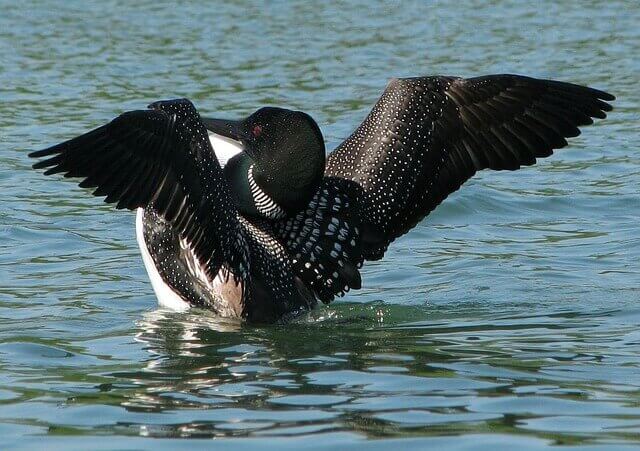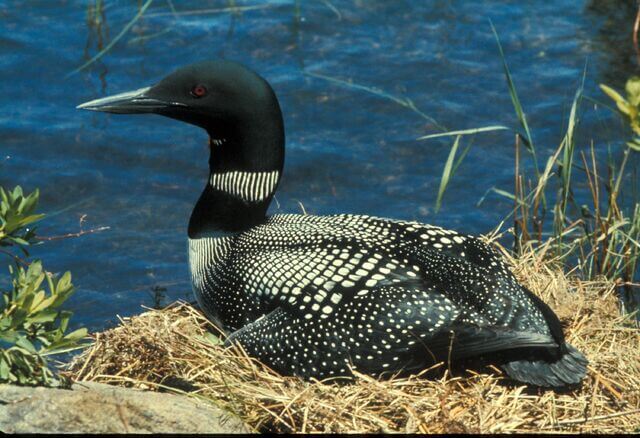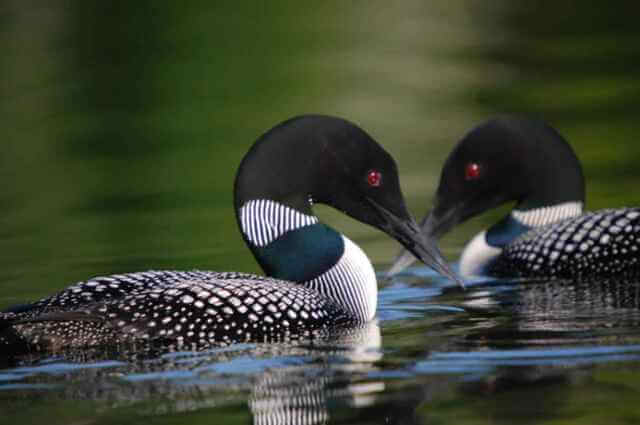Loons are some of the most popular birds in the world, but many people don’t know much about them. In this article, we’ll provide you with 13 Fascinating Common Loon Facts you may not know.
Table of Contents
Common Loon Facts
- Kingdom: Animalia
- Phylum: Chordata
- Class: Aves
- Order: Gaviiformes
- Family: Gaviidae
- Genus: Gavia
- Species: G. immer
- Scientific Name: Gavia immer (Brunnich, 1764)
Identification
The common loon can be identified by its summer breeding plumage, iridescent black head and neck, black-and-white checkered back, black bill, red eyes, two white necklaces, one bigger and one smaller.
In the winter they turn to a more mottled brown coloration with dark feathers on their head and upper parts which are lighter underneath.
Range
The common loon is a water bird that lives in the Northern Hemisphere. The species can be found throughout North America, Europe and Asia. It breeds mainly in northern parts of Canada, Russia and Scandinavia.
Size
How big is the common loon? The average size of a Common Loon ranges from 27-29 inches long and has a wingspan of about 4 feet. Male loons are usually larger than females, but it can be difficult to tell them apart.
The biggest differences between males and females are that males have brighter plumage with more reds and blues, while females’ feathers appear more brownish or grayish.
- Length: 25.0-35.0 in (63.5-88.9 cm)
- Weight: 87.0-216 oz (2500-6100 g)
- Wingspan: 40-52 in (101.6-132 cm)

Food Sources
Common Loons eat fish, amphibians, crustaceans, rodents, muskrats, insects, larvae and plants. Fish is their main food source; however, they will scavenge for other types of prey if needed. These birds are often seen floating, scanning for fish below the surface of the water.
It’s not uncommon to see them diving head first into the water from a great height in order to catch a meal. It’s believed that loons eat about 3 pounds of fish per day, which equates to 1/4 pound every hour!
Predators
The adults are mainly only threatened by bald eagles, and ospreys, but their eggs and young fledglings can fall prey to foxes, mergansers (a type of duck), snapping turtles, raccoons, otters, and fish such as muskie and northern pike.
Another threat is from human activities. Fishing equipment such as lures, hooks, fishing lines, and nets can cause them to become entangled in the lines, causing them to drown. Humans who accidentally scare birds away from their nest areas by shooting or injuring them with guns, rifles, bows, or fishing nets are another threat.
Habitat
The loons have a diverse habitat, they live on freshwater lakes and ponds or saltwater coastal habitats such as estuaries. Loons may also inhabit large inland waterways that have plenty of shallow areas where it can rest comfortably on the bottom of the riverbeds.
Social
Common loons are a type of bird that is not known for being sociable. In fact, they have the reputation of being one of the most antisocial birds in North America. This notion comes from their tendency to stay away from others and avoid interacting with them at all costs.
However, this was disproved by scientists who found out that common loons do interact with other types of birds like herring gulls and cormorants during nesting season as well as migrating seasons.
Sounds
The Common Loon is a large bird that has an unmistakable sound. The Loon’s song consists of three to five notes, the wail, tremolo, hoot, and yodel.
These notes are generally low, medium, and high. Each of the notes has two variations, namely the loud and softer note.
This common loon makes these sounds in succession during courtship displays and territorial fights with other loons, or during nest-building activities at their nesting site or nearby predators.
- Listen to Sounds and Calls
Population
Although it is not known exactly how many loons exist, it is estimated that there are about 500,000-700,000 individual birds that are found in North America. Most of them are found in the southern part of the United States and Canada.
Migration
It migrates during autumn to winter in the Southern Hemisphere, while it spends its winters on lakes near its breeding grounds.
The migration route starts from the Arctic Ocean and goes south through Northwest Territories, Manitoba, Saskatchewan, Montana and South Dakota before reaching Texas by October or November.
The typical length of time that it takes for a common loon to complete its migration depends on where they’re migrating from, but usually ranges between 3-6 months.
The length of their migration path can be anywhere between 1,600 miles (2,575 kilometers) to 2,800 miles (4,565 kilometers).

Nesting
Loon nesting habits are complex and different depending on their habitat. In North America, loons nest in lakes near large trees or tall bushes for protection from wind and predation. The female builds a bowl-shaped nest out of aquatic vegetation such as bulrushes, rushes, sedges, and grasses.
She then lines it with soft plant material to keep her eggs warm while incubating them. The male often stays on the nest to keep watch while she is out feeding.
Conservation
They are “least concern” on the IUCN Red List, meaning they are not endangered. It has been determined by the International Union for Conservation of Nature to be “least concern”, which means it is not currently threatened with extinction and there is no evidence that its population size has declined sharply.
Fun Facts
- The sound of the common loon is so loud and haunting it can be heard from over one mile away!
- The average life span for a common loon is around 20 years.
- Loons are members of the order Gaviiformes, which means they’re in the same family as pelicans and gannets.
- Loons have been known to swim over 100 miles per day!
- Loons mate for life and can be monogamous for life.
- Loons have webbed feet which allow them to swim underwater as well as glide above the surface of the water.
- The term “loon” comes from an Old English word meaning “a diver.”
- Loons have distinctive voices that can be used to identify them even at a distance underwater; some loons’ calls sound like someone laughing or crying out “Whoa!”
- The loon can stay underwater for 5 to 10 minutes.
- They swim by moving their feet and using their wings as paddles to push against the water’s surface.
- Loons migrate during the winter to escape harsh weather conditions.
Frequently Asked Questions
How fast can loons swim?
The speed at which a loon swims has been recorded in various sources as being anywhere from 9 miles per hour to 20 miles per hour.
Can a loon take off from land?
Loons are a bird that can only take off from water. Their bodies are not designed for it, so instead of taking flight, they will just walk around or try to get back into the water. Once they are in the water, they need to have a long run before they can launch themselves into the air.
What are baby loons called?
The common name for baby loons is “loon chick.” Loon chicks are born with dark yellow downy coat with a white belly and are very small. They can swim very well, but aren’t strong enough to fly until they are about two weeks old. By six to eight weeks old, loon chicks start to develop their distinctive plumage. They can fly by the time they are ten to eleven weeks old.
How deep can a loon dive?
However, not many people know that loons can dive to depths greater than 200 feet and remain underwater for as much as five minutes! Loon dives are deep because they hunt fish and other aquatic prey, but it also helps them avoid predation from birds like eagles or herons.
Can a loon walk?
A loon can walk, but they look very awkward doing it. A loon’s center of gravity is too far back for them to balance on their legs. They cannot stand up straight because they are so top-heavy.
Related Post: 17 Birds That Swim Underwater (with Photos, ID, & Info!)




